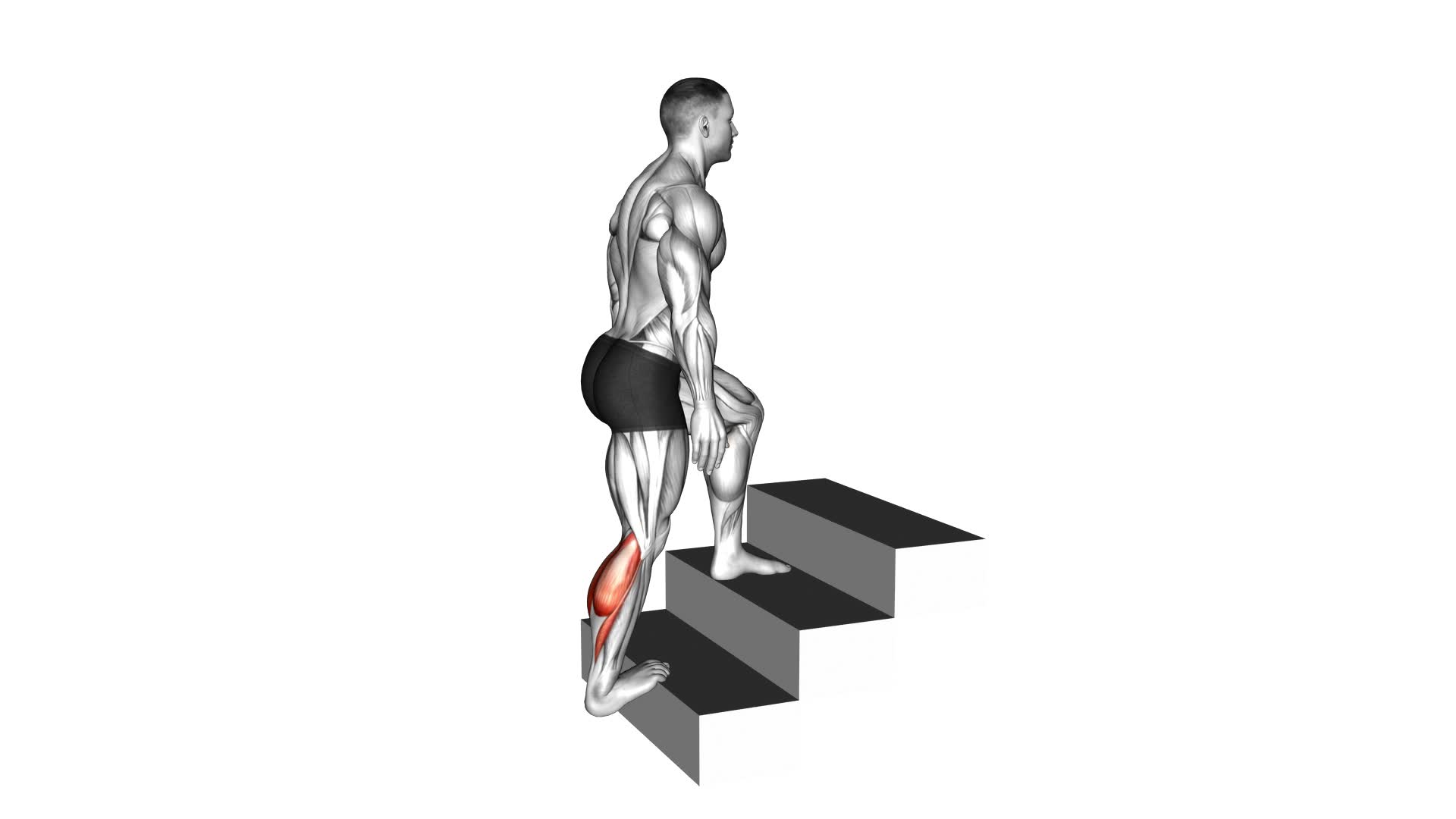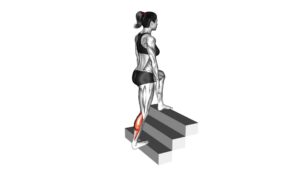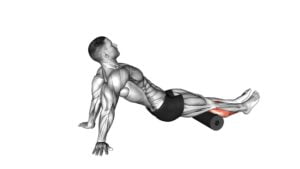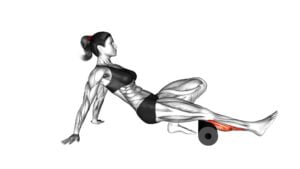Calves Stretch (Male) – Video Exercise Guide & Tips

Are you looking to improve your calf flexibility? Look no further!
Watch This Exercise Video
In this video exercise guide, we will show you the proper technique for the calves stretch. By following these tips, you can avoid common mistakes and maximize the effectiveness of this stretch.
Whether you're a beginner or an advanced athlete, we've got you covered with variations suitable for all levels.
Get ready to stretch those calves and achieve your fitness goals!
Key Takeaways
- Regularly incorporating calf stretches into your workout routine can help maintain overall lower body strength and improve range of motion.
- Calves stretches can prevent calf muscle injuries and reduce the risk of strains and injuries.
- Calves stretches enhance blood circulation in the lower legs, alleviate muscle tightness and discomfort, and aid in preventing muscle imbalances in the lower body.
- Proper technique and variations of calf stretches, such as using an incline surface or adding resistance, can maximize effectiveness and provide different challenges for the muscles.
Benefits of Calves Stretch
You should regularly incorporate calf stretches into your workout routine to reap the numerous benefits they offer. Calf flexibility is of utmost importance in maintaining overall lower body strength and preventing calf muscle injuries. By stretching your calves, you improve their range of motion, allowing for better performance in activities such as running, jumping, and squatting. Additionally, flexible calves can help alleviate tightness and discomfort in the lower legs and feet.
One of the key benefits of calf stretches is the prevention of calf muscle injuries. When the calf muscles are tight and inflexible, they're more prone to strains, tears, and cramps. Stretching helps to lengthen and loosen the muscles, reducing the risk of these injuries. By incorporating calf stretches into your routine, you can enhance your athletic performance and reduce the likelihood of setbacks due to calf muscle issues.
Now that you understand the importance of calf flexibility and how it helps prevent injuries, let's move on to the next section, which will focus on the proper technique for calf stretches.
Proper Technique for Calves Stretch
To perform the calf stretch correctly, start by standing with your feet shoulder-width apart. This exercise is an essential part of any stretching routine, as it helps improve calf muscle flexibility and prevents tightness.
Begin by stepping forward with your right foot, keeping your heel on the ground. Slowly bend your left knee while keeping it straight and extend your left leg behind you, ensuring your foot remains flat on the floor. You should feel a stretch in your calf muscle.
Hold this position for about 20 to 30 seconds, focusing on deepening the stretch without causing any pain. Repeat the stretch on the other side by stepping forward with your left foot and extending your right leg behind you.
To enhance the stretch, you can also lean forward slightly, keeping your back straight, and pushing your hips forward. This will intensify the stretch in your calf muscle.
Remember to breathe deeply throughout the stretch and avoid bouncing or jerking movements. It's crucial to perform the calf stretch correctly to maximize its benefits and prevent injury.
Incorporating this stretch into your regular stretching routine will help improve calf muscle flexibility and enhance overall lower body mobility.
Common Mistakes to Avoid
When performing the calf stretch, be mindful of the most common mistakes to avoid. Proper technique is crucial for injury prevention and maximizing the effectiveness of this exercise. Here are four common mistakes you should be aware of:
- Bouncing: Avoid bouncing or using jerky movements during the calf stretch. This can put excessive stress on the muscles and increase the risk of injury. Instead, perform slow and controlled movements to ensure a safe and effective stretch.
- Overstretching: While it's important to stretch the calves, overstretching can lead to strain or injury. Avoid pushing yourself too far beyond your comfort zone. Gradually increase the intensity of the stretch over time to avoid overstretching.
- Incorrect foot positioning: Placing your feet incorrectly can compromise the effectiveness of the calf stretch. Make sure your toes are pointing straight ahead and your heels are firmly on the ground. This will target the correct muscles and prevent unnecessary strain on the ankles.
- Holding your breath: Many people tend to hold their breath while stretching, but this can actually restrict oxygen flow to the muscles. Remember to breathe deeply and exhale slowly as you perform the calf stretch. This will help relax the muscles and enhance the overall stretch.
Advanced Variations of Calves Stretch
To take your calf stretch to the next level, incorporate advanced variations that challenge your muscles even more. These advanced modifications can help increase the intensity and effectiveness of your calf stretch routine.
One advanced variation is to perform the stretch on an incline surface, such as a step or a slant board. This will provide a deeper stretch and engage your calf muscles in a different way.
Another option is to use resistance bands or weights to add resistance to the stretch. This will further challenge your muscles and help increase strength and flexibility.
You can also try performing the stretch with one leg at a time, either by crossing one leg over the other or by holding onto a stable object for support. This will allow you to focus on each calf individually and increase the stretch on that specific leg.
Lastly, using a foam roller or massage ball can help release tension in your calves before and after stretching. These equipment options can enhance your stretch routine and provide additional benefits for your calf muscles.
Incorporating these advanced variations and equipment into your calf stretch routine will help you progress and continue challenging your muscles.
Tips for Maximizing Calves Stretch Effectiveness
Maximize the effectiveness of your calves stretch by incorporating these tips:
- Maintain proper form: To get the most out of your calves stretch, it's essential to maintain proper form throughout the exercise. Keep your back straight, chest up, and shoulders relaxed. Avoid leaning forward or backward, as this can reduce the effectiveness of the stretch.
- Engage your core: Engaging your core muscles during the calves stretch can help stabilize your body and enhance the stretch. Focus on pulling your belly button towards your spine and contracting your abdominal muscles while performing the exercise.
- Stretch both calves: It's important to stretch both calves to ensure balanced flexibility. Many people tend to focus on one side more than the other, leading to muscle imbalances. Take the time to stretch both calves equally to maximize the effectiveness of the exercise.
- No equipment needed: One common misconception is that you need fancy equipment to effectively stretch your calves. However, all you really need is a flat surface, such as the floor or a step. You can easily perform the calves stretch using your body weight and gravity to create the desired stretch.
Frequently Asked Questions
How Long Should I Hold Each Stretch When Doing the Calves Stretch Exercise?
When stretching your calves, it's important to consider how long to hold each stretch.
The duration of the stretch can vary depending on your goals and current level of calf muscle flexibility. Holding each stretch for around 20-30 seconds is a good starting point.
This allows enough time for your muscles to relax and lengthen.
Regular stretching not only improves flexibility but also helps prevent injuries and enhances overall athletic performance.
Can the Calves Stretch Exercise Help to Improve My Balance and Stability?
Calf stretches can indeed improve your balance and stability. By targeting the muscles in your calves, these stretches help to strengthen them, which in turn enhances your overall stability.
When your calves are strong and flexible, you're less likely to lose your balance or stumble during activities that require stability, such as walking or running.
Incorporating calf stretches into your routine can provide you with the added benefits of improved stability and better overall balance.
Is It Recommended to Do the Calves Stretch Exercise Before or After a Workout?
To get the most out of the calves stretch exercise, it's important to know when to do it.
Before your workout, this stretch can help prepare your muscles, increase blood flow, and improve range of motion. This can lead to better performance and reduce the risk of injury.
After your workout, the calves stretch can help relax and lengthen your muscles, promoting recovery and reducing soreness.
Are There Any Modifications or Alternative Exercises for Individuals With Limited Ankle Mobility?
If you have limited ankle mobility, there are alternative exercises and modifications you can try to stretch your calves. These exercises can help you achieve similar benefits while accommodating your specific needs.
By focusing on exercises that target the calf muscles without putting excessive strain on the ankle joint, you can still work towards improving your calf flexibility and strength.
Remember to consult with a fitness professional or physical therapist for personalized guidance based on your specific limitations.
Can Performing the Calves Stretch Exercise Regularly Help to Prevent or Reduce the Risk of Calf Muscle Injuries?
Performing the calves stretch exercise regularly can help prevent or reduce the risk of calf muscle injuries.
Stretching your calves helps improve flexibility and range of motion, which can prevent muscle strains and tears.
By stretching, you're also increasing blood flow to the muscles, which promotes healing and reduces soreness.
Incorporating this exercise into your routine can provide long-term benefits for preventing injuries and keeping your calf muscles strong and healthy.
Conclusion
In conclusion, the calves stretch exercise is a great way to improve flexibility and prevent muscle tightness in the lower legs. By following the proper technique and avoiding common mistakes, you can effectively target the calf muscles.
For those looking for a challenge, there are advanced variations to try. Remember to maximize the effectiveness of the stretch by incorporating these tips into your routine.
Keep stretching and enjoy the benefits it brings to your overall fitness.

Author
Years ago, the spark of my life’s passion ignited in my mind the moment I stepped into the local gym for the first time. The inaugural bead of perspiration, the initial endeavor, the very first surge of endorphins, and a sense of pride that washed over me post-workout marked the beginning of my deep-seated interest in strength sports, fitness, and sports nutrition. This very curiosity blossomed rapidly into a profound fascination, propelling me to earn a Master’s degree in Physical Education from the Academy of Physical Education in Krakow, followed by a Sports Manager diploma from the Jagiellonian University. My journey of growth led me to gain more specialized qualifications, such as being a certified personal trainer with a focus on sports dietetics, a lifeguard, and an instructor for wellness and corrective gymnastics. Theoretical knowledge paired seamlessly with practical experience, reinforcing my belief that the transformation of individuals under my guidance was also a reflection of my personal growth. This belief holds true even today. Each day, I strive to push the boundaries and explore new realms. These realms gently elevate me to greater heights. The unique combination of passion for my field and the continuous quest for growth fuels my drive to break new ground.



